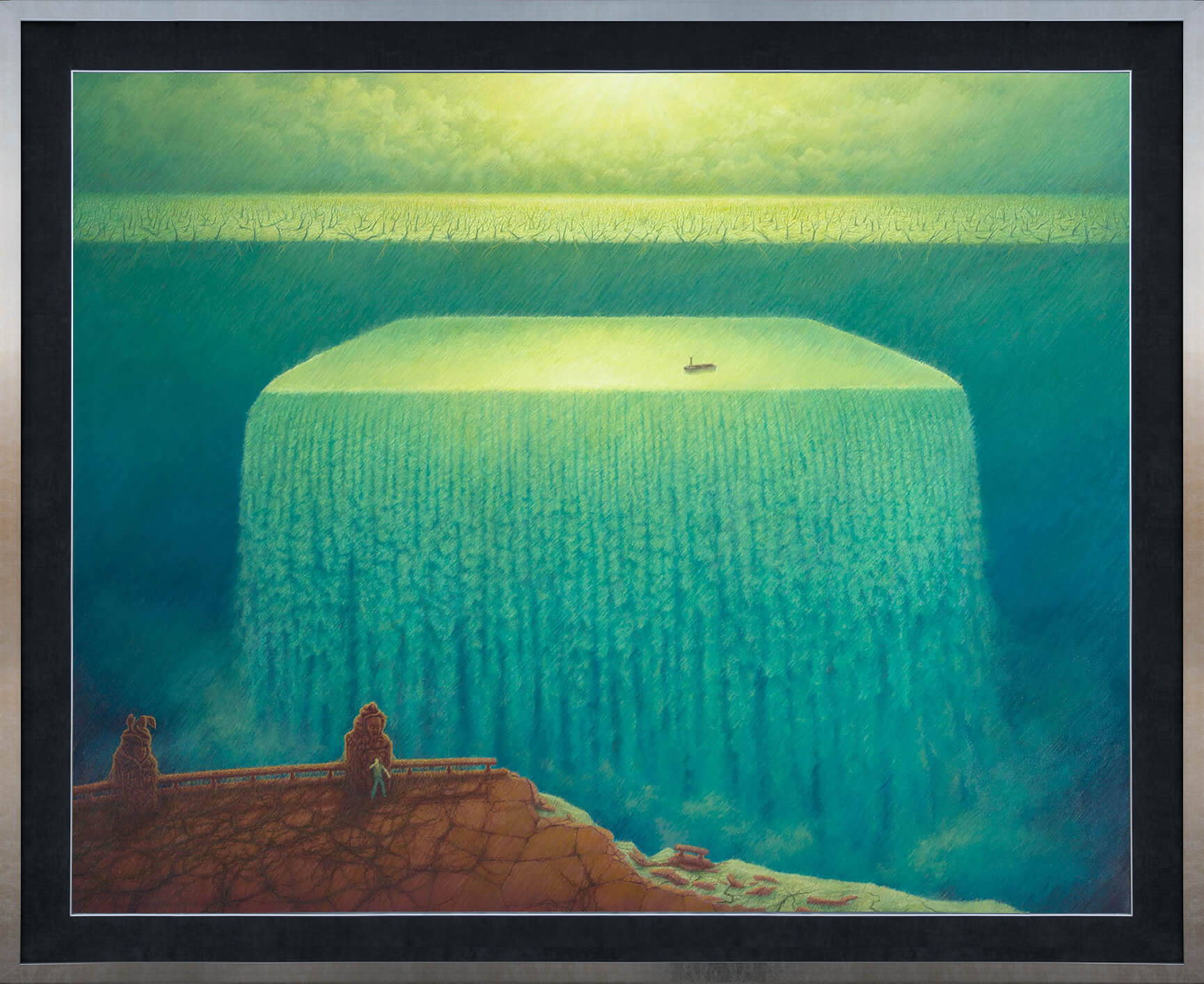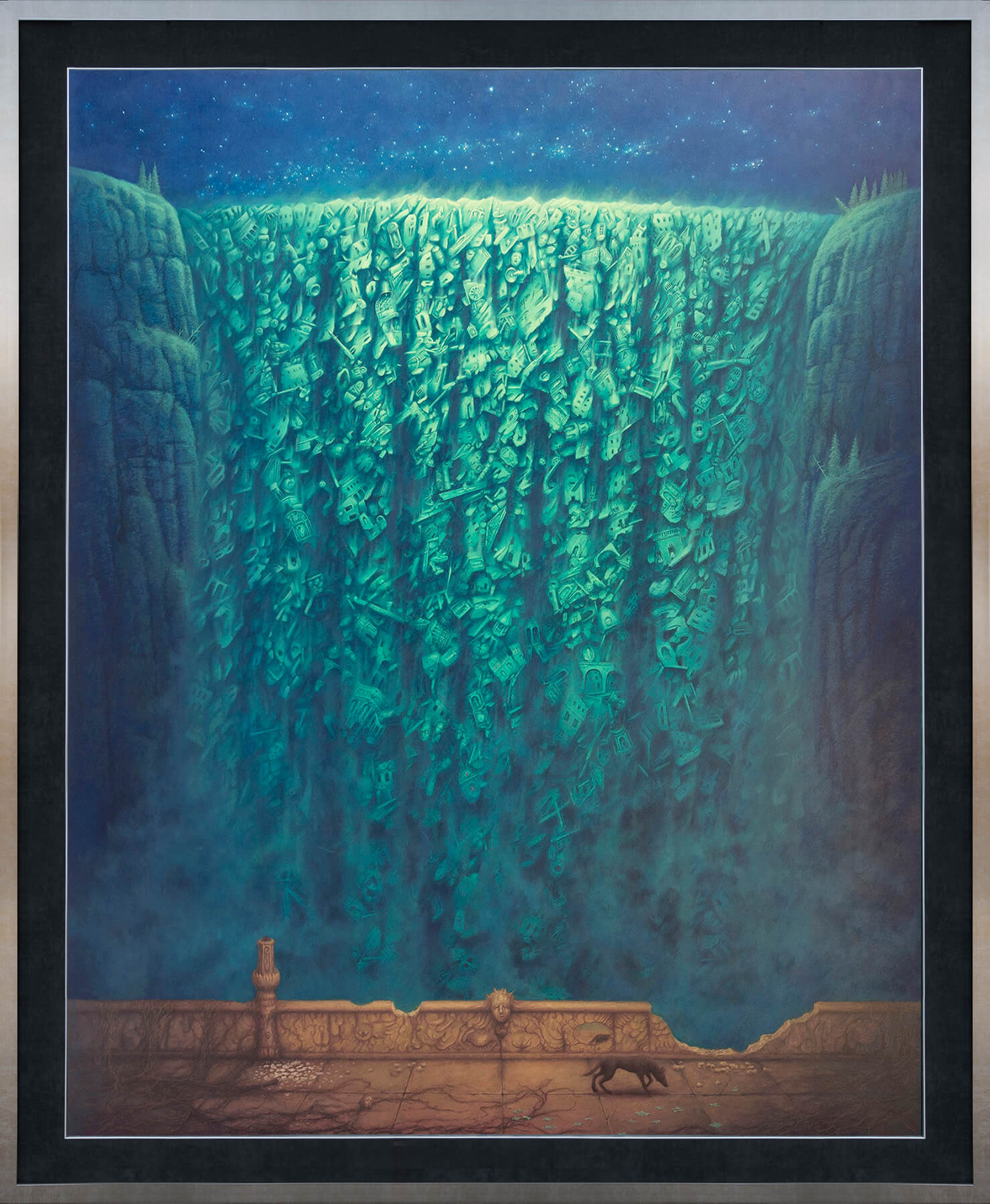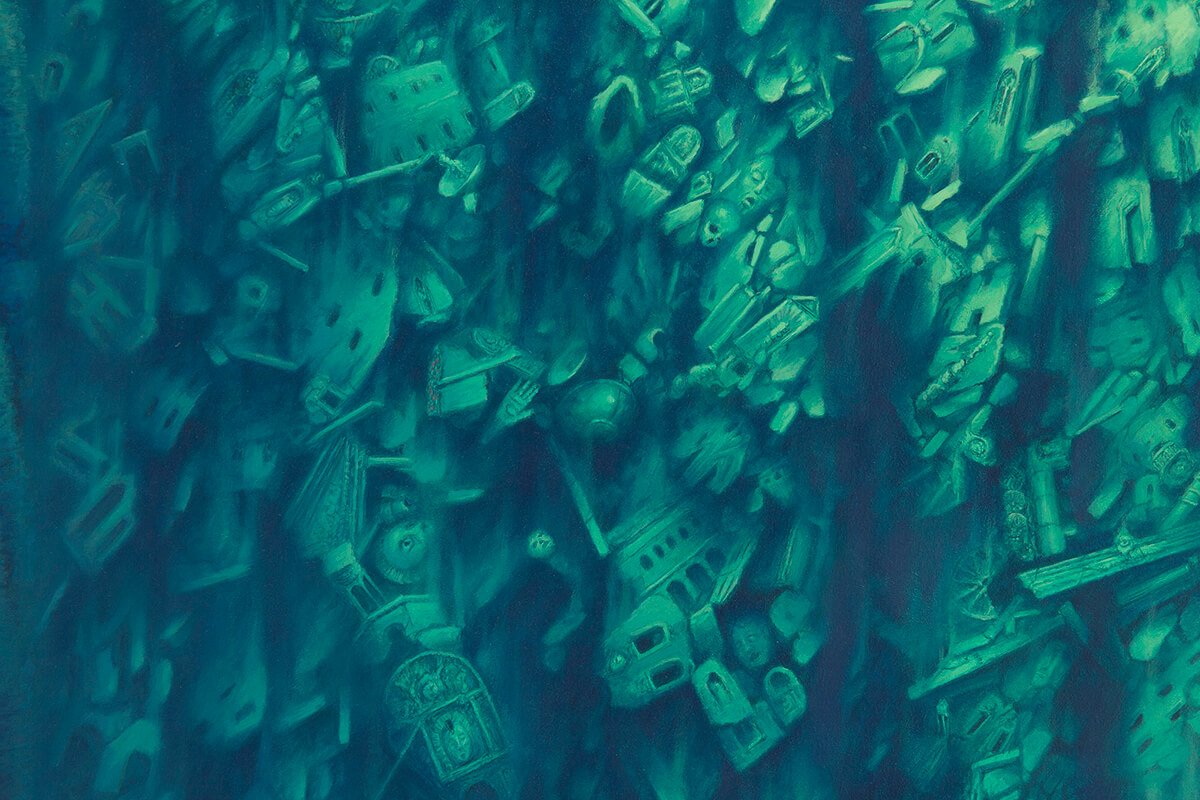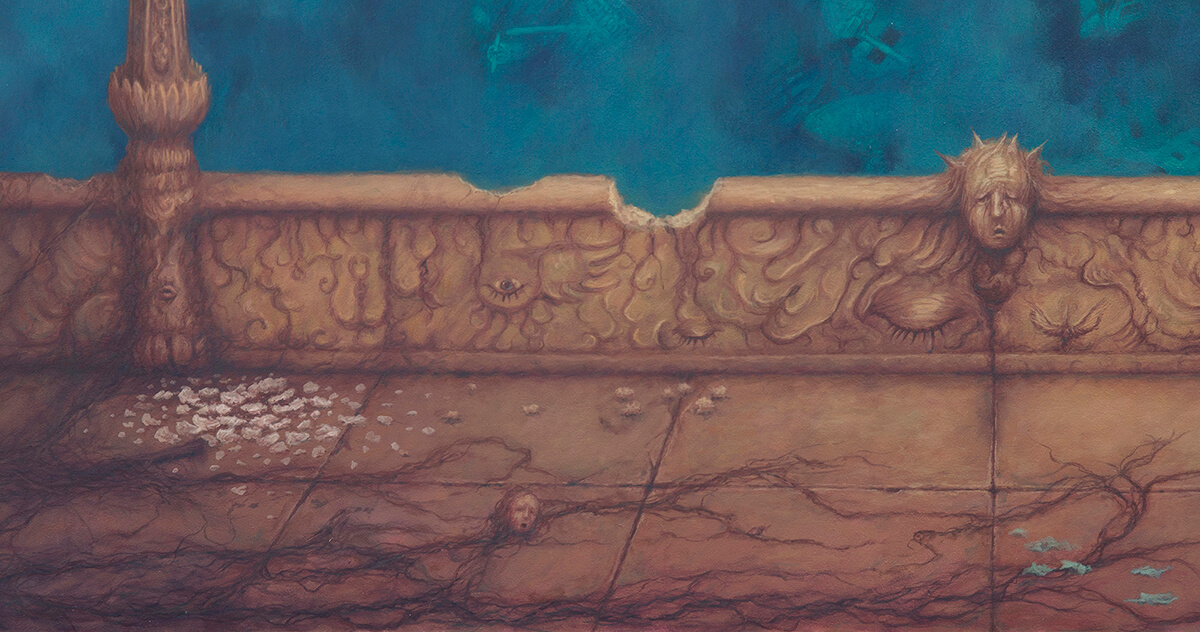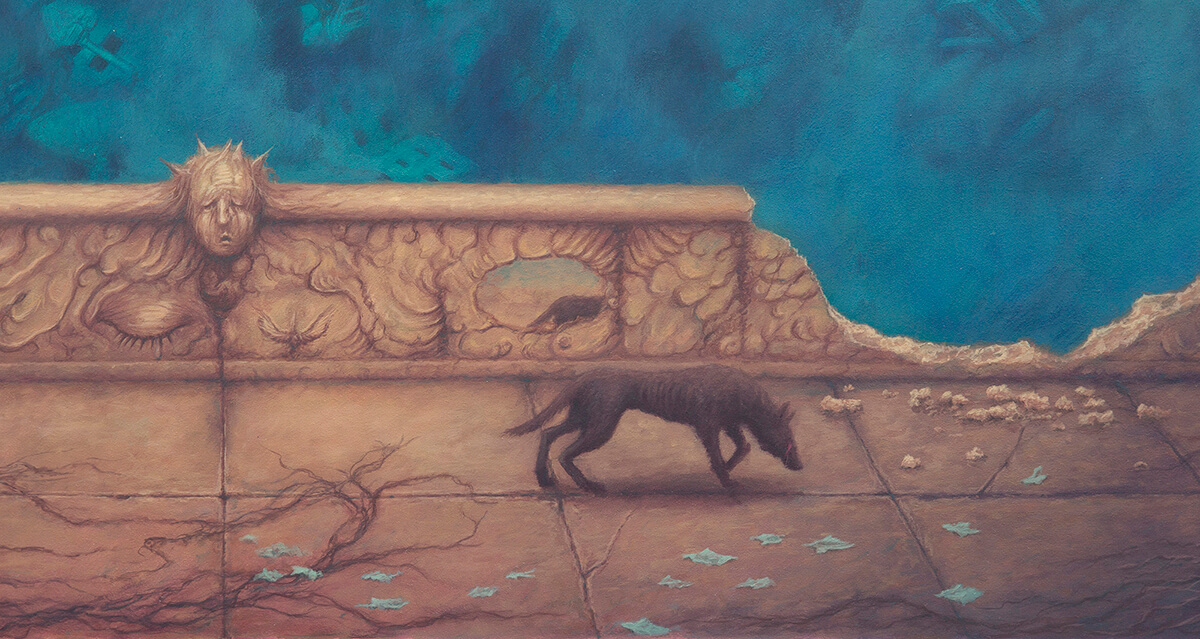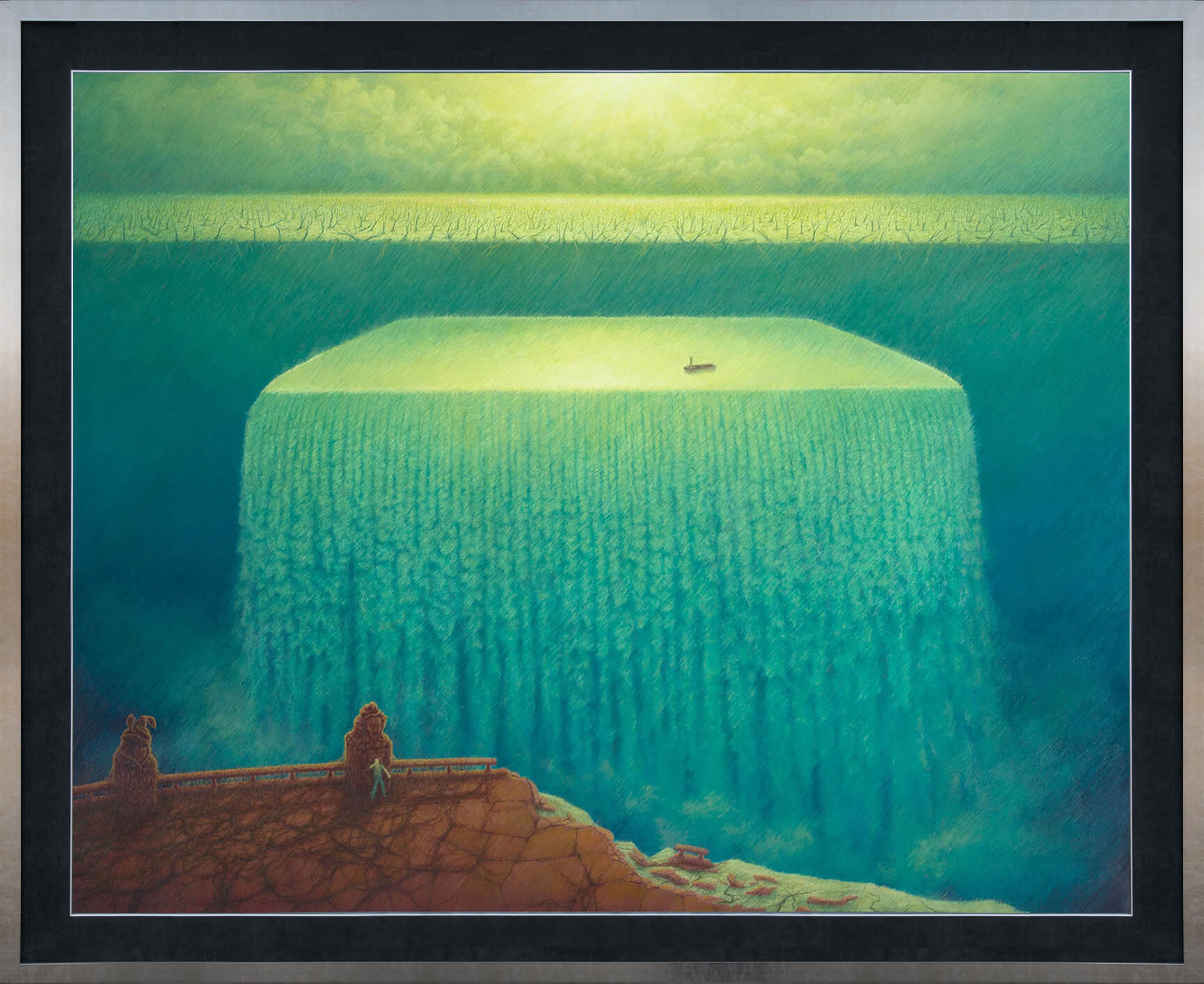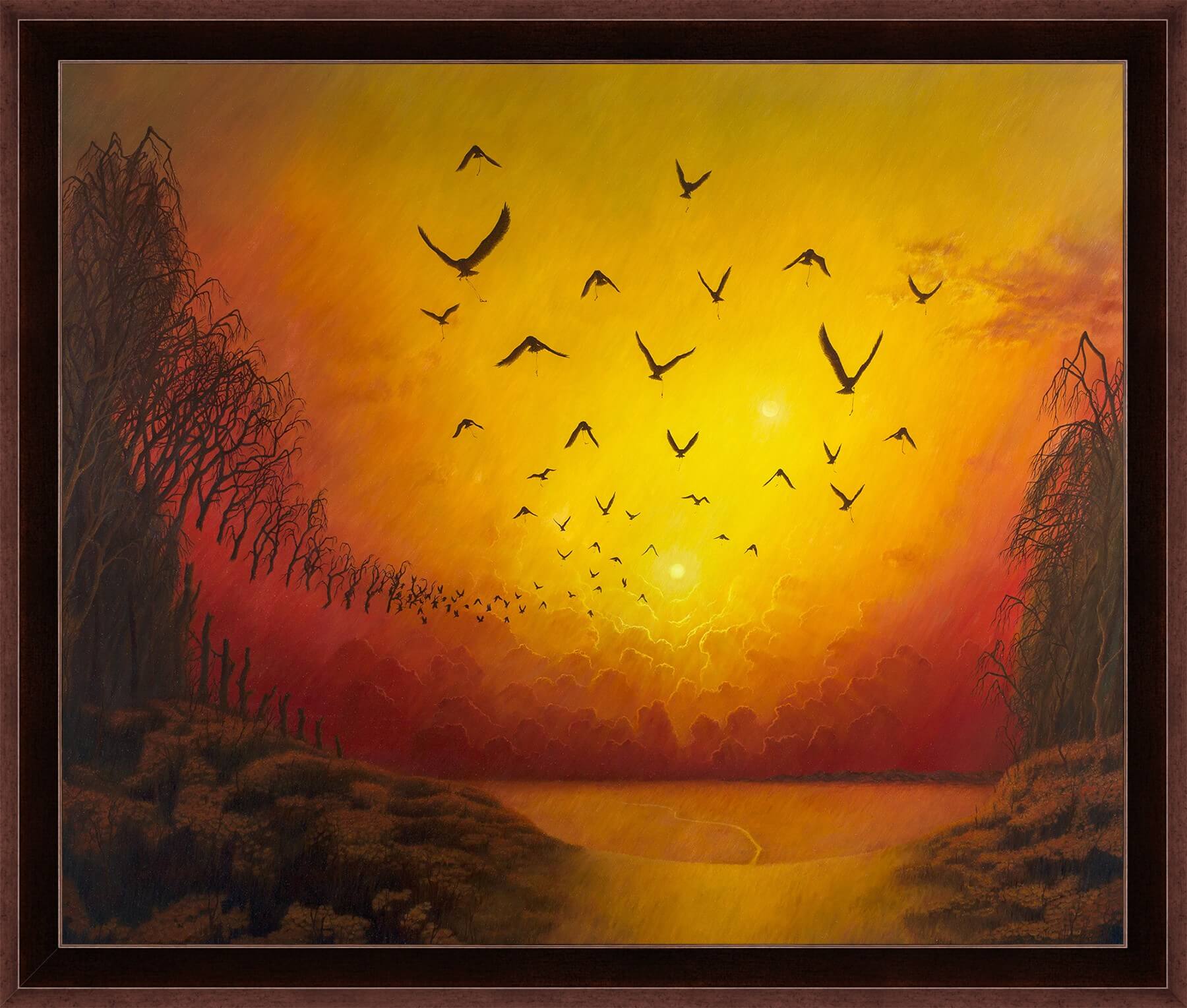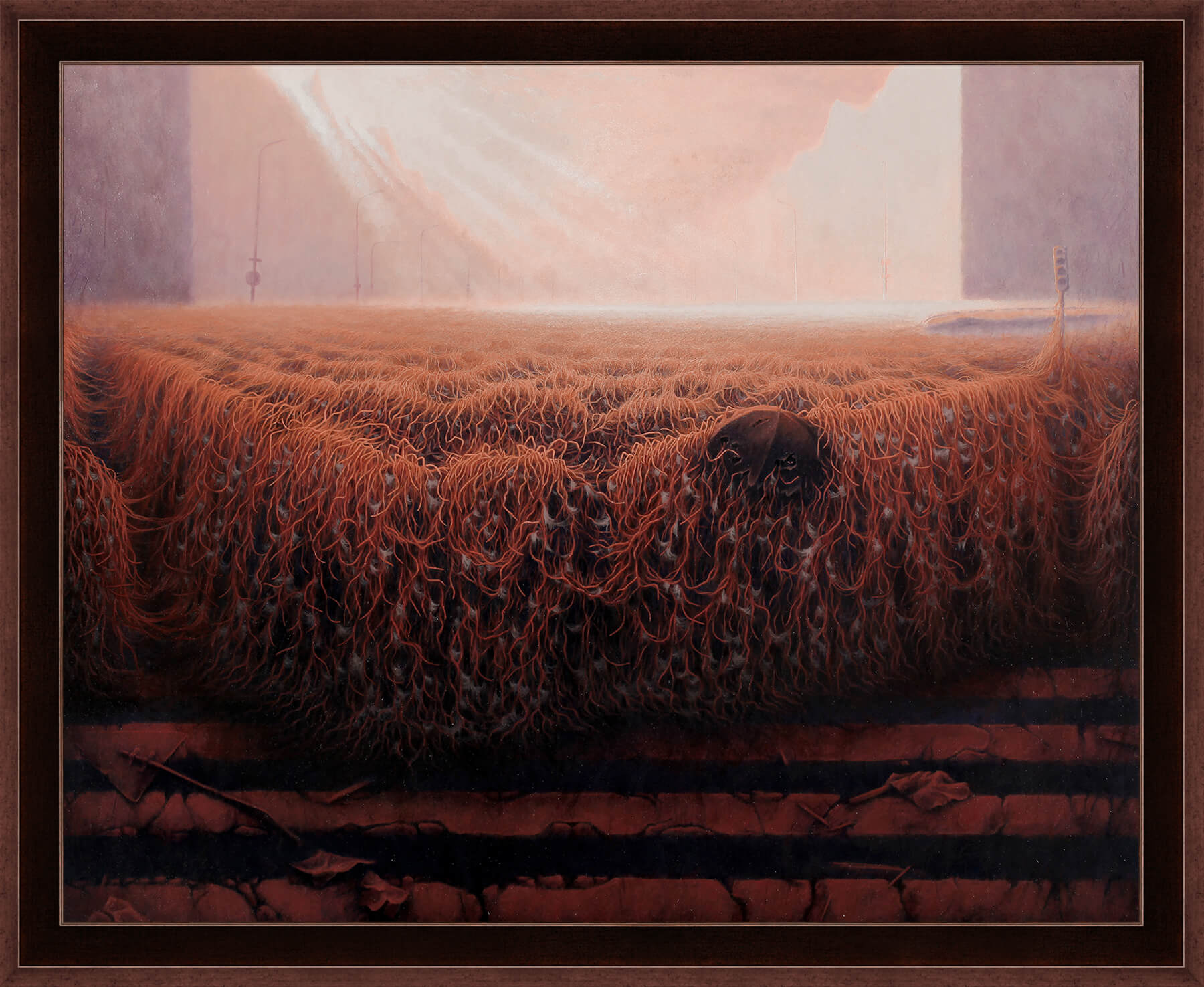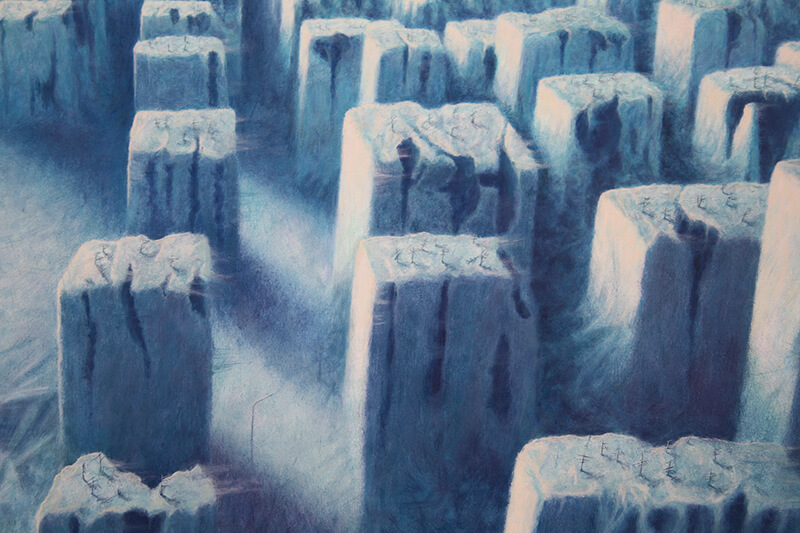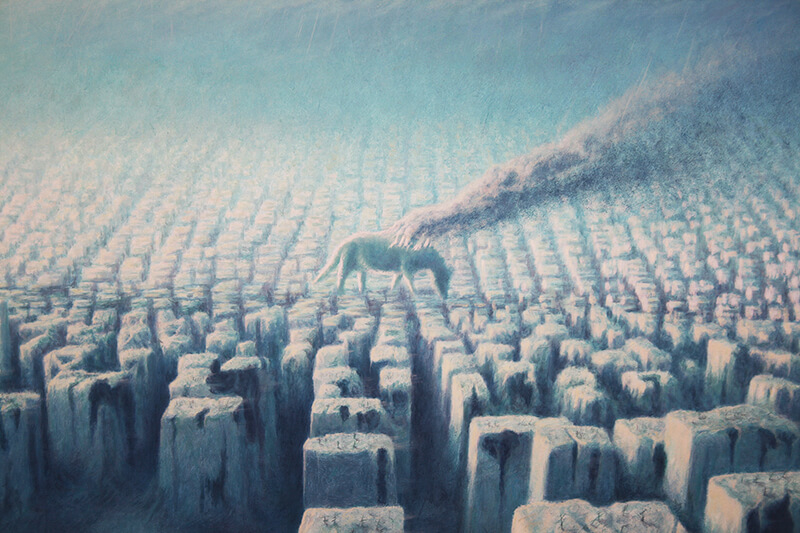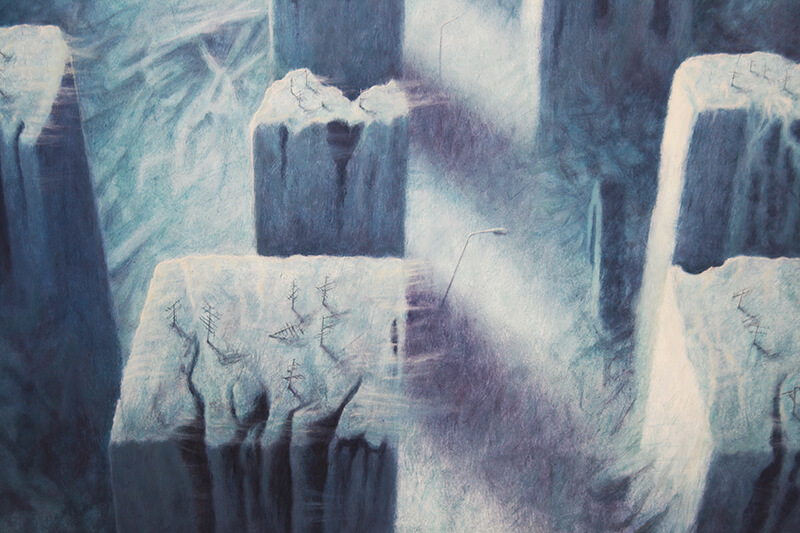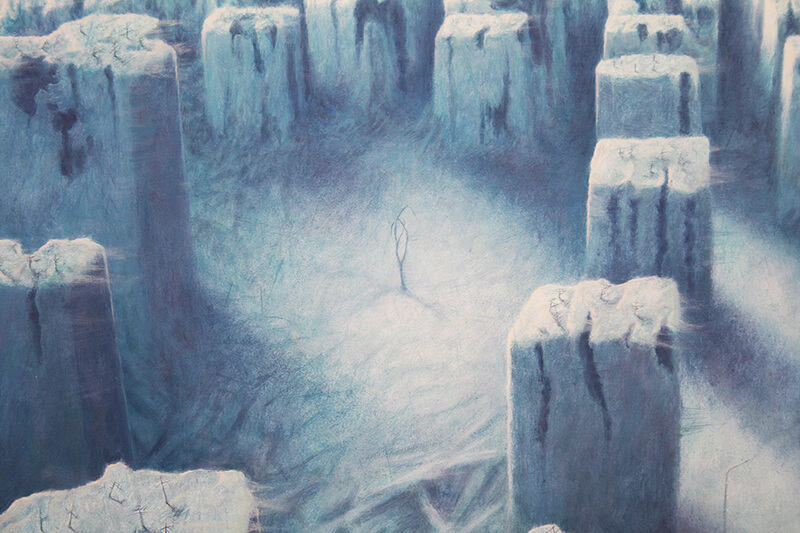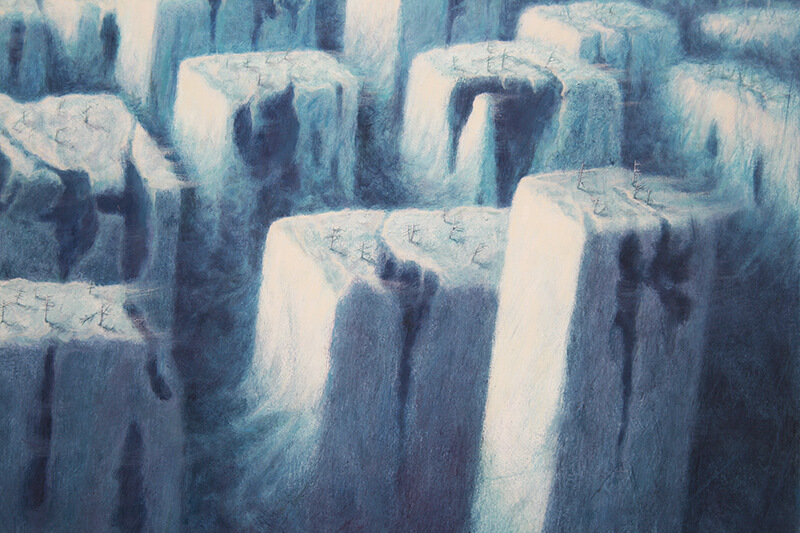It is my great pleasure to invite you to the Sopockiedo Auction House auction, which will take place on June 19, 2021. at. 17:00, where my painting can be auctioned. This work can be seen at the pre-auction exhibition from June 5 to June 19 in Sopot, ul. Bohaterów Monte Cassino 43. I cordially invite you! 🙂 https://www.sda.pl/…/zbigniew-oporski-wodospad,33815,pl From myself: this picture is the last one successfully painted with the technique of specific slanting strokes. I have a great fondness for it, because it is a stage of an intense search for the expression of applying paint taken from pencil drawing. I wanted to find a way that would delicately suggest nervousness, or rather emotional agitation of the author, who would paint such a scene on a regular basis or under the influence of intense experiences, e.g. sleep, while taking care of quality and detail. Once, one of the viewers said – which surprised me positively – that he had the impression that it was painted with rain. Only a few pictures were created in this way, and I consider this and one of two small birds over a dark ravine the most successful. It was this search that gave birth to the style of painting in which I suppose I will settle for longer.
 Zbigniew Oporski
Zbigniew Oporski
PICTURE ON AUCTION “THE ART OF IMAGINATION” ORGANIZED BY AGRA ART – SOLD!
What to write !? Great joy for selling the painting at the Art of Imagination Auction organized by the Agra Art Auction House !!! Many thanks and congratulations to bidders and I hope the painting will enjoy the eye of the new buyer. Many thanks to Marszand for support !!!
AUCTION OF THE ART OF THE IMAGINATION ORGANIZED BY AGRA ART 06.06.2021
Hello everyone ![]() I am pleased to inform you that on May 6th at On the 18th, the Art of Imagination Auction organized by Agra Art will be held, where my painting will be available, for which I am very fond of. The painting can be seen at the pre-auction exhibition from April 25 in the gallery at ul. Wilcza 70, from 11am to 6pm. Below are links to the auction of my painting and the entire event. I invite everyone!
I am pleased to inform you that on May 6th at On the 18th, the Art of Imagination Auction organized by Agra Art will be held, where my painting will be available, for which I am very fond of. The painting can be seen at the pre-auction exhibition from April 25 in the gallery at ul. Wilcza 70, from 11am to 6pm. Below are links to the auction of my painting and the entire event. I invite everyone!
http://sztuka.agraart.pl/licytacja/476/28896
https://www.agraart.pl/aukcja-sztuka-wyobrazni-6-maja/
A FEW WORDS ABOUT HOW THE PAINTING OF THE “BLUE CITY” WAS CREATED
The painting depicting a dead city covered by a huge sheet carried by birds was created in 2021, and the work on it took two months and was finished at the turn of March and April. I do not remember when the idea on this topic arose: whether it appeared as a variation of the city with a pet, or maybe it arose at a different time. And I remember the frame that appeared before my eyes, which was similar to the one presented, and the starry sky as the third plan of the whole. On the constructional level, I wanted a kind of pathos of the scene, in which flying headsless birds hold a damaged canvas, which is ultimately intended to cover the city, completing its end. Originally the birds were supposed to scream to add more drama to the scene, but after painting the sketch, I found silence to be more fitting and without losing the drama. That is why I removed the heads of the birds, which probably made everything even more dead. The initial idea was a huge fabric lying on the ground, which birds pulled over the ruins like a huge sheet, but in the course of work I thought to connect the second plane (fabric) with the third (sky), so that the sheet would flow down from the sky. I found it a more interesting solution and painted it. I wanted a highly saturated light reflected from the sky, which was balanced by a soft reddish light above the horizon on the opposite side. All this to reinforce the unreality of the situation. Sometimes I have dreams in this kind of lighting. As a complement to the whole, on one of the buildings I painted a figure making a silencing gesture. I do not want to describe the philosophical, or perhaps more ideological, part in order not to spoil the viewer’s inquiries and, contrary to appearances, it is not too great. When the painting entered the detail stage, the silence I thought at the sketch stage turned into the beginning of Carmina Burana’s “O Fortuna” with the characteristic sound of a choir, so sometimes I looked at it as a spectacle of silence, and at other times in the background I heard the beginning of the aforementioned work by Carl Orff. The picture is 100 x 118 cm and it is painted in oil technique on an aluminum plate.
PENCIL CYCLE – ONLY WORKS OF THIS
Pencils. The series consists of twelve works created in 2013 in Warsaw, after considerable life changes and waiting for a return to Szczecin. I do not plan to return to this technique anymore, so the works will be a kind of "white crows". Except for one, the rest are 100 cm by 70 cm. Below I show the available ones.
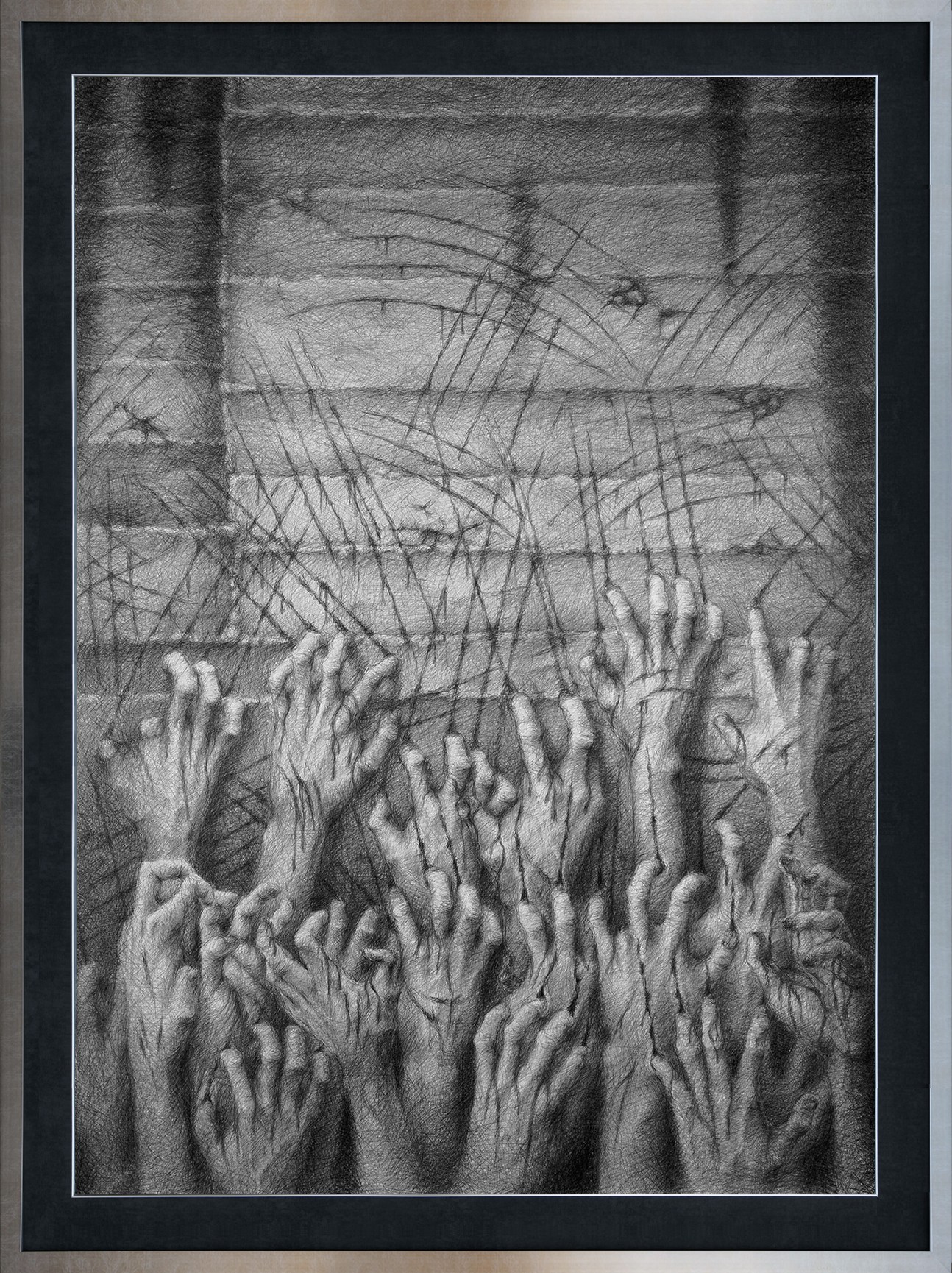
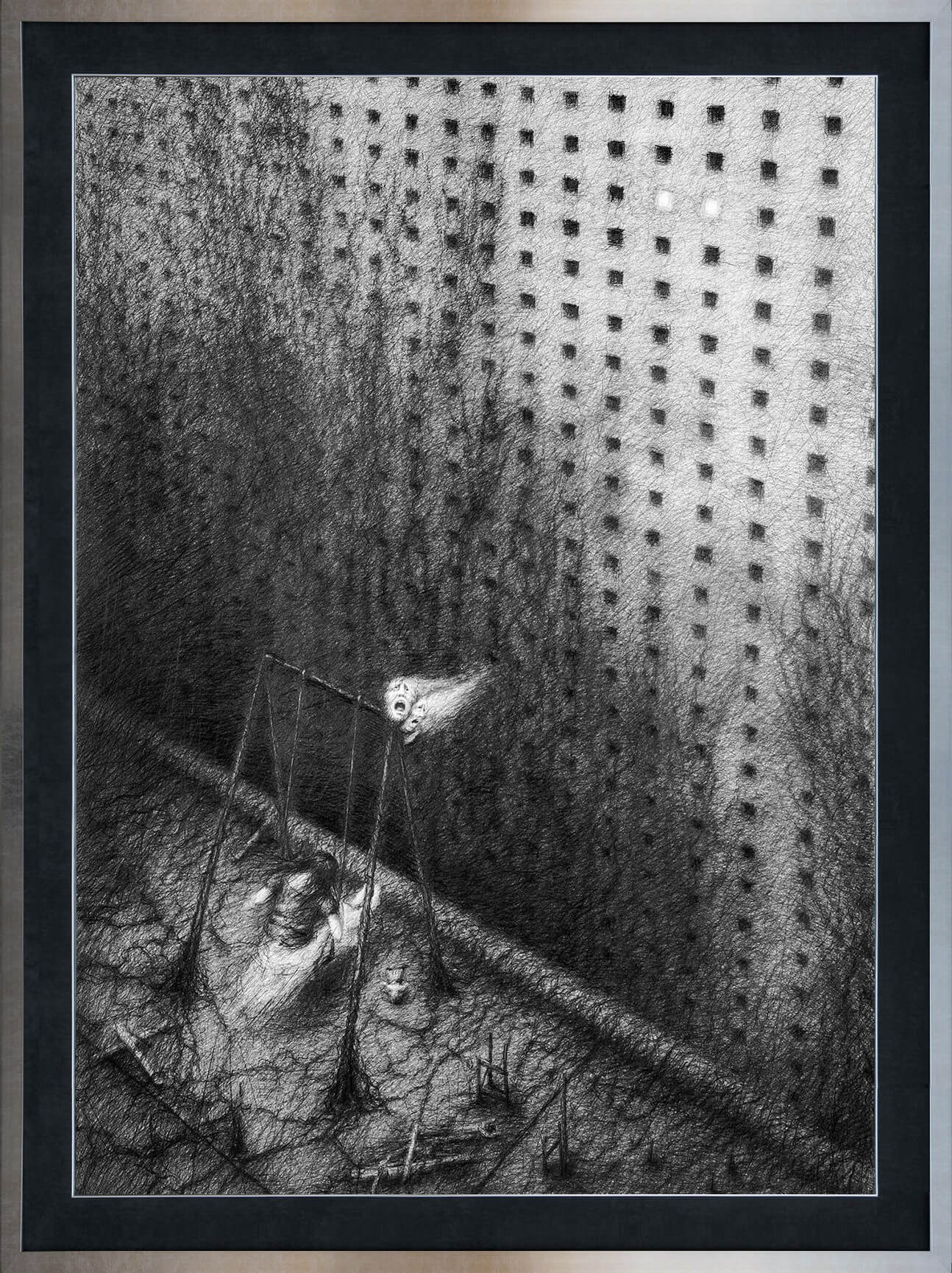
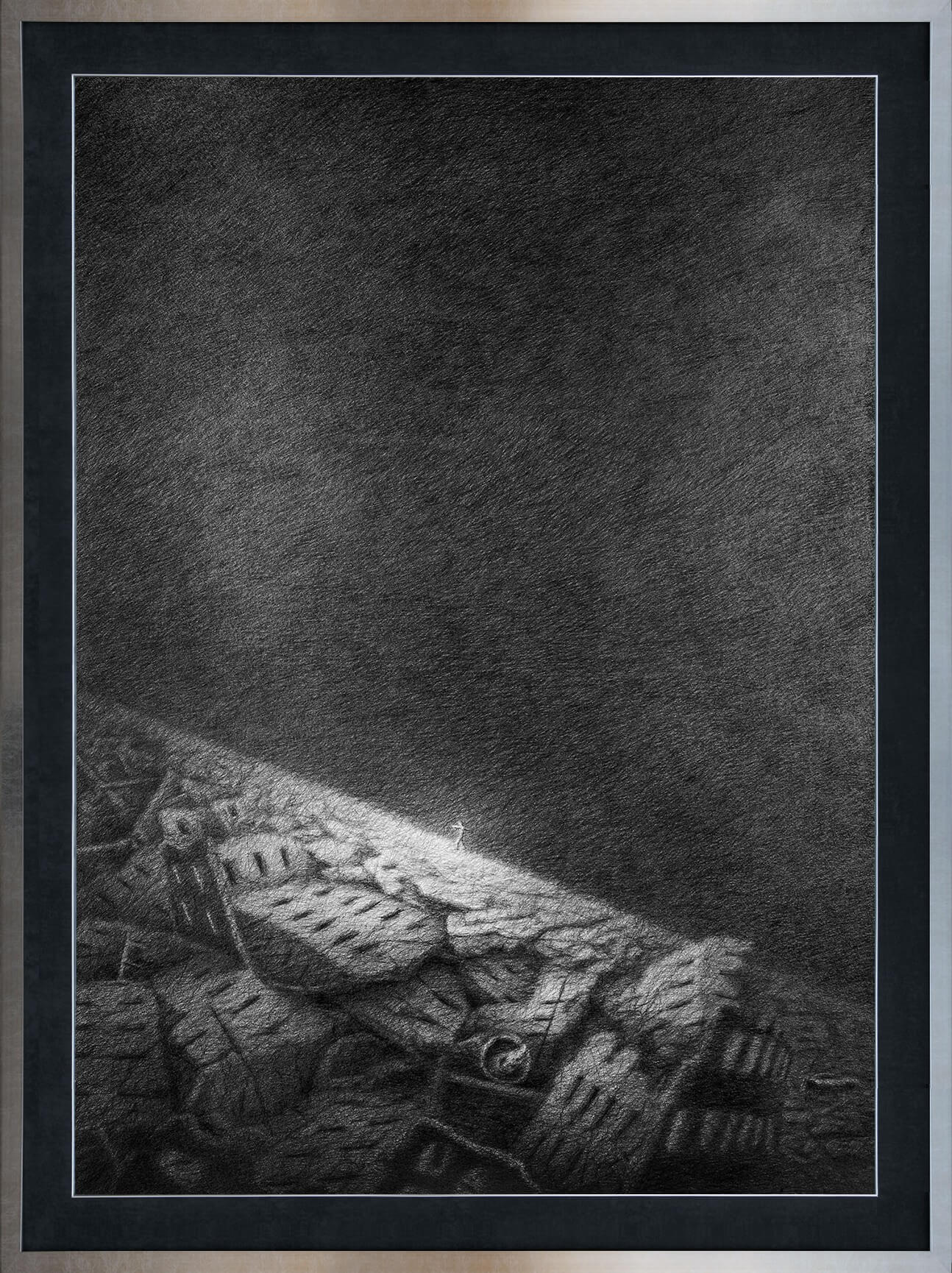

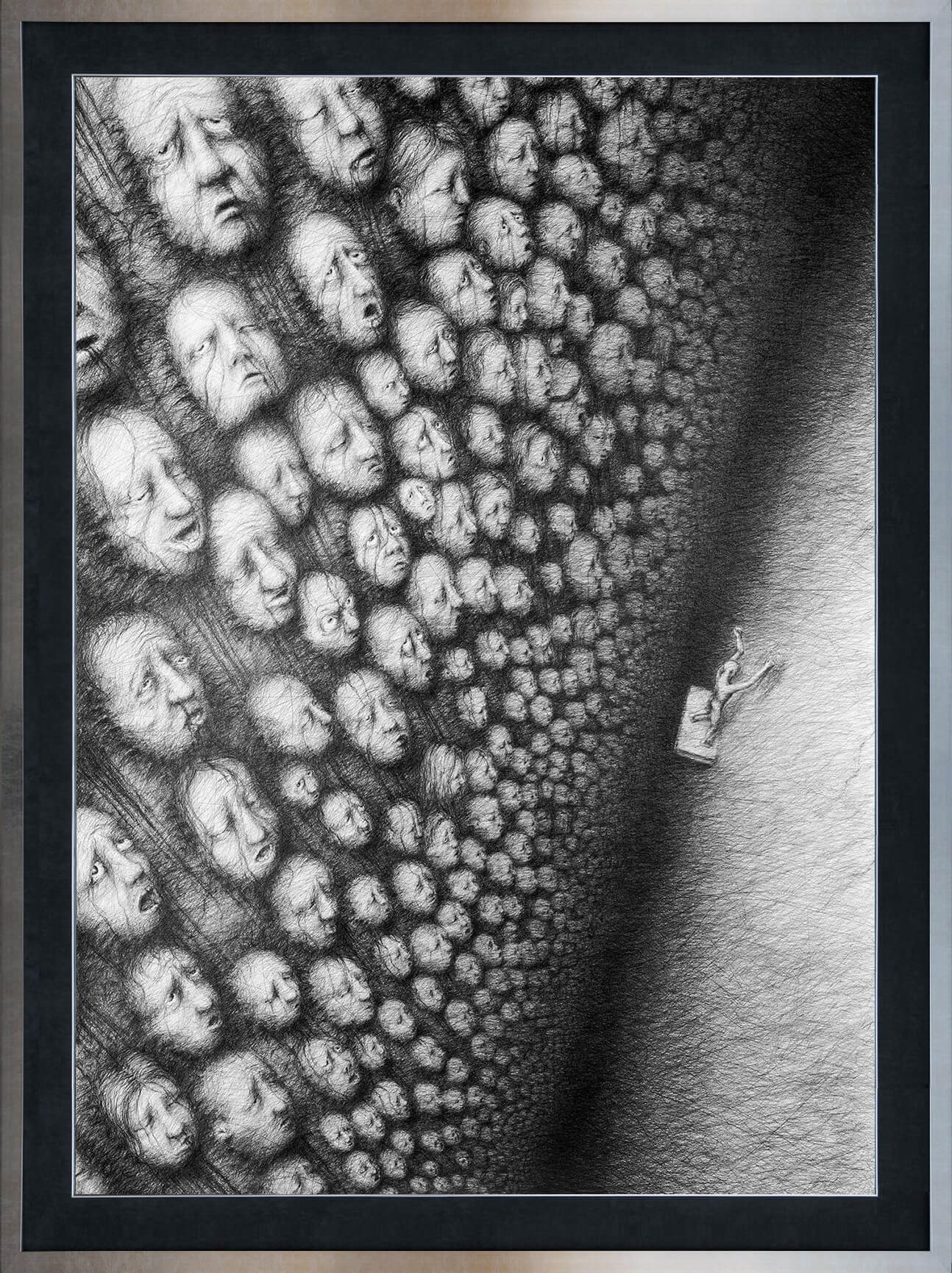
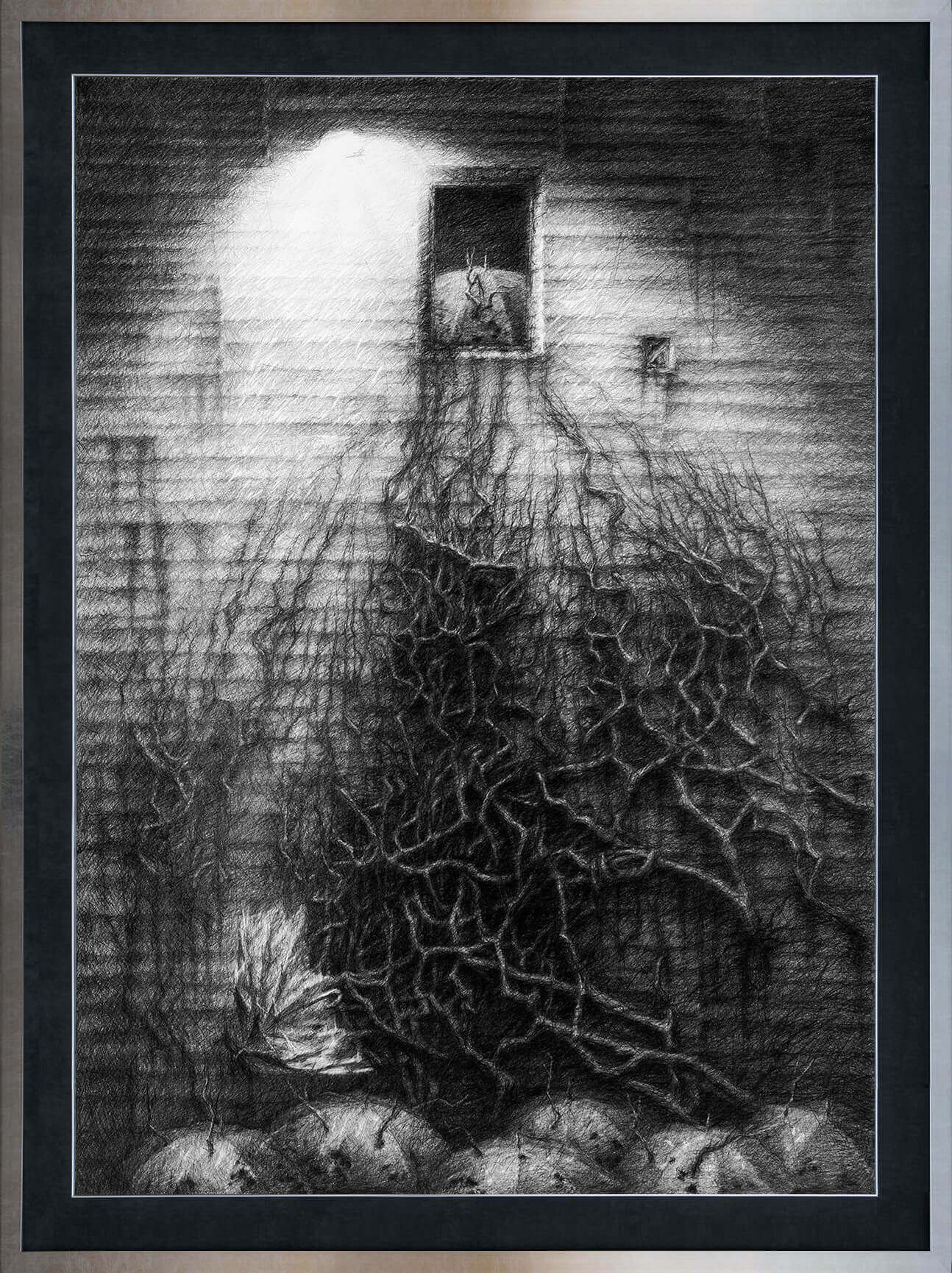
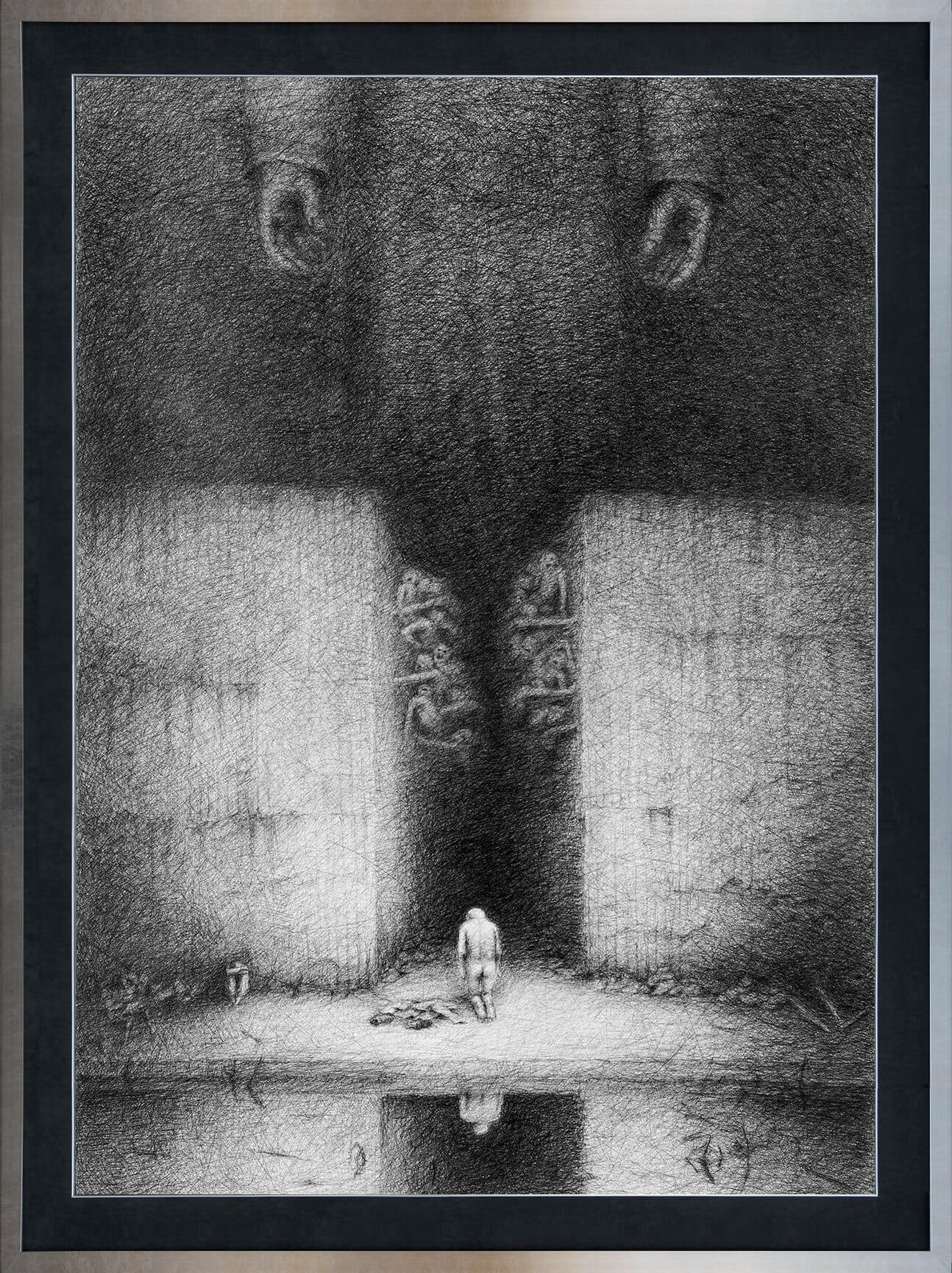
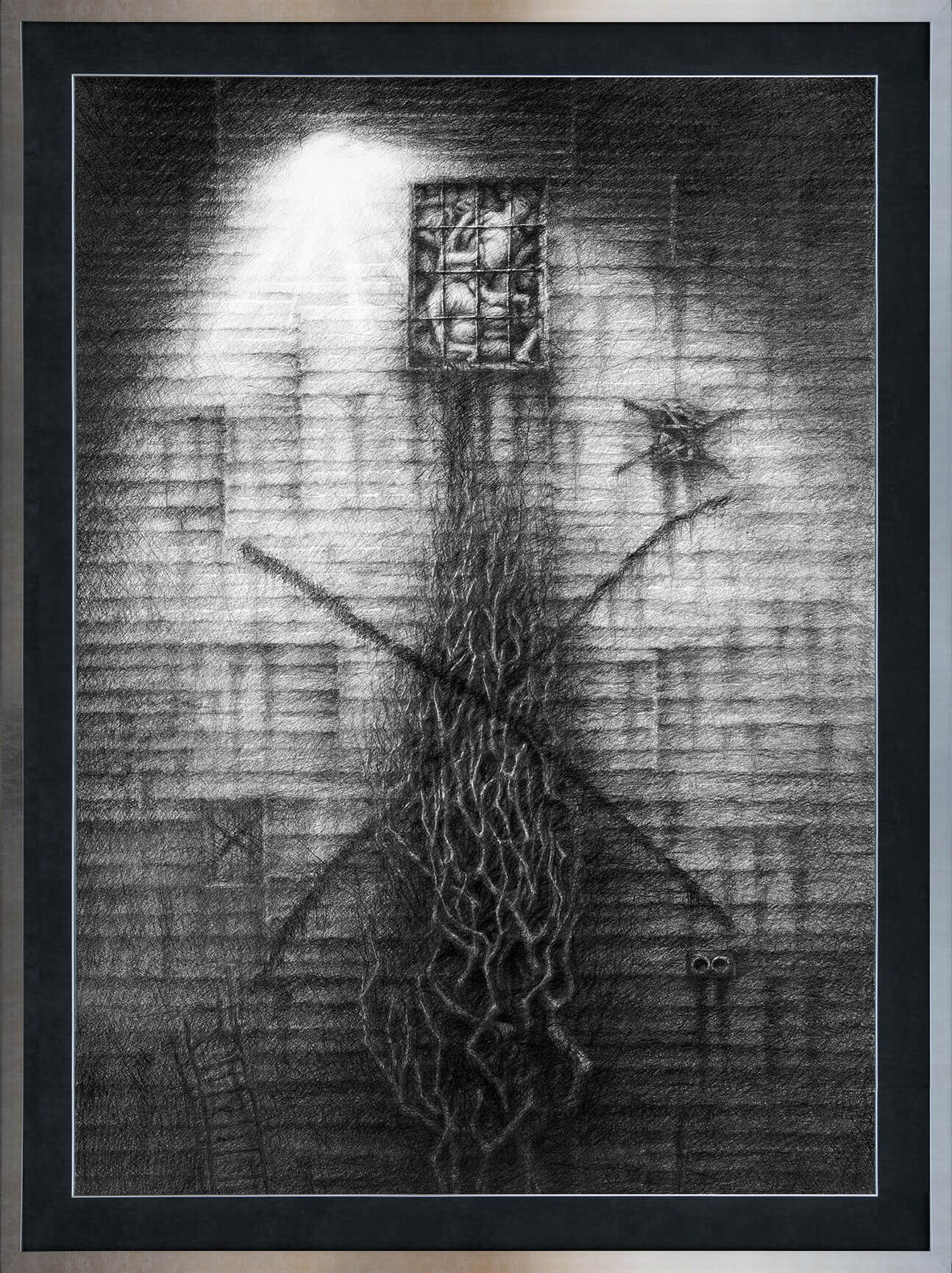
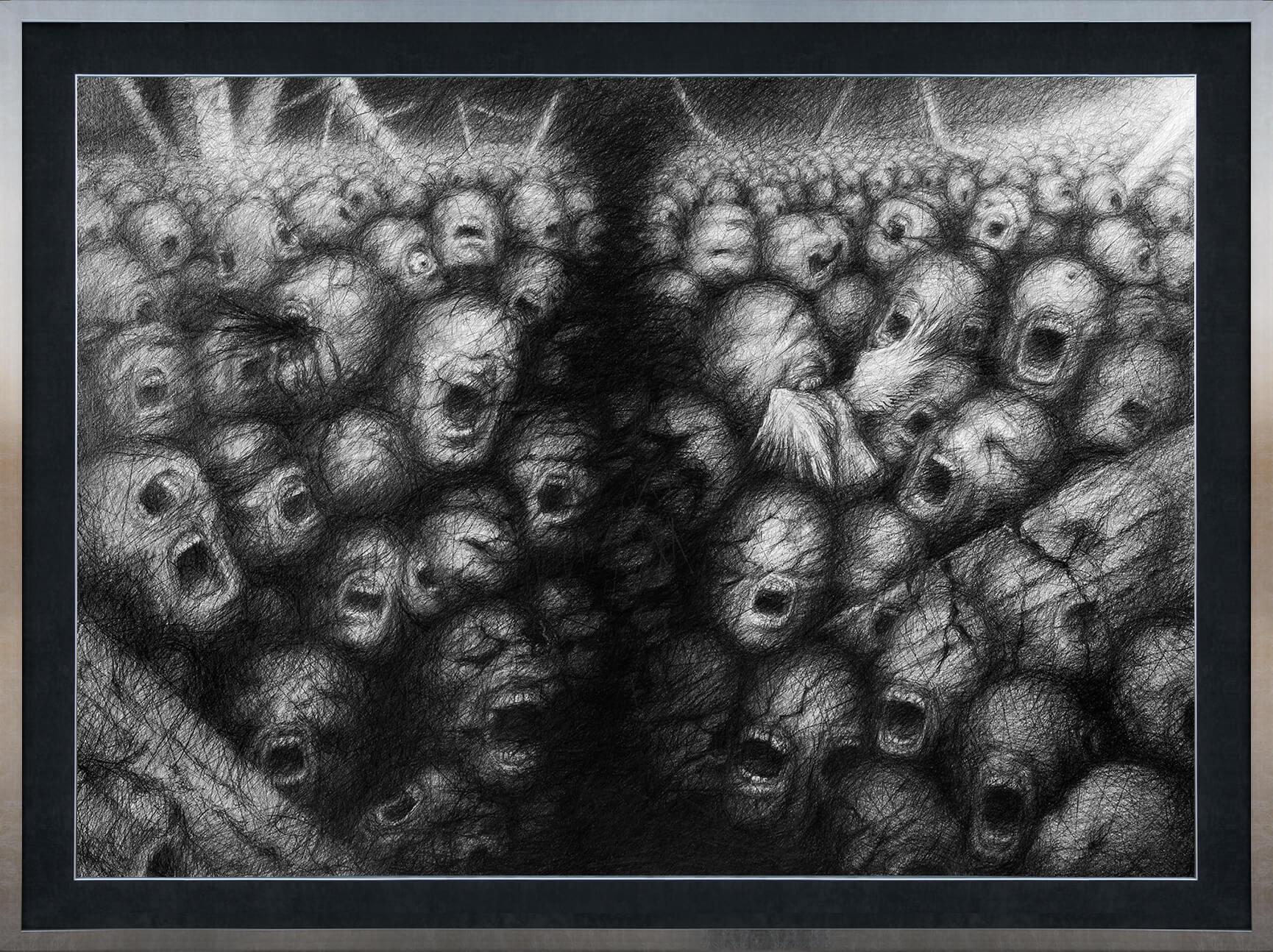
TEXT ABOUT HOW THE “GRUZOSPAD” WAS CREATED
I paint my pictures on anodized aluminum plates as supports, which I consider to be one of the most durable ones, which you can read about in professional literature. Painted in 2020, the picture, tentatively called “Gruzfall”, measuring 124 cm high by 100 cm in the base, is to date a record holder in terms of the time spent on its creation, oscillating around four months. Such a long period resulted from the adoption of the painting method, which I chose from two, namely: either I transform a waterfall into ruins, mainly architecture, or a riuna into a waterfall. I chose the latter, much more labor-intensive, requiring the use of fine brushes for the entire “water” surface, of which I used a dozen, if not several dozen. Then the worked out detail started to blur, remake, shade appropriately until the final form. The idea for its creation was inspired by the earlier work, i.e. a square waterfall placed inside a huge space. This picture was hanging on my wall and at one point, while peeking, I saw a vision connecting the decaying buildings with the waterfall in front of me, and I immediately imagined, or rather “heard” the accompanying huge boom. While sketching I already knew that there was no point in sticking to one scale and only architecture. Thus, apart from the various sizes of scraps of architecture, there are the strangest elements that came to my mind relatively freely, or other elements that I “saw” in the spots while painting. In this work – colloquially speaking – I gave free rein to my imagination and the number of quirks grew with the time of painting the picture. The bottom was originally supposed to be simplified, consisting only of a railing and a sniffing dog, but the imagination won. “Gruzfall” gave rise to derived visions and its versions will certainly appear in the future. The picture is certainly for viewers who like detail, patient, analyzing the work centimeter by centimeter, because there are a whole lot of fantastic, incomprehensible or even intentionally contradictory elements, which I do not want to indicate so that the viewer can discover more of them over time and perhaps seeing the seeds of future images. All this in a sea of questions and reflections.
TEXT ABOUT HOW THE PAINTING WITH THE 2019 FOUR-SANGLE WATERFALL WAS CREATED
The painting showing a square waterfall against the background of a huge pit was created in the period when I was looking for expression in the way of applying paint, started by a pencil sketch made in 2013. Well, while making this sketch with slightly negligent lines, drawing it in the direction which is assigned to me by right-handedness, I was surprised to notice that the drawing “came to life giving the impression of moving”. I knew this effect not only from previously seen pencil works or from the history of painting (e.g. impressionism), but to know something and to understand this are two different things, even different states of mind. Then I realized that expression can come not only from the topic and form of work, but also from the nature of using a given tool. I began to care about a kind of nervousness of the line so that the viewer would feel that the work was created in emotional turmoil. Since I made the lines diagonally, later, in oil, I decided to adapt this method and several pictures were created in this style, including the waterfall in question, which was the first I ever painted. To this day, I attach great importance to the method of applying the paint and, most likely, there will be more changes ahead of me. The topic itself did not come out of nowhere because there is an element that constantly appears in my head, namely a huge, flat surface, implicitly concrete, with withered and sometimes scarred stumps that were once trees. The first picture where such a thing appeared was a large pit stretching towards the horizon above which two, scared and losing feathers birds were flying. The side planes were covered with the mentioned dead trees. The painting was in turquoise tones. Some time later I thought, why not do something similar while looking at the chasm perpendicular from one of the shores? As the bottom itself seemed quite boring to me, the main topic appeared, i.e. the waterfall, but one from which the water was to be drawn from out of nowhere. Why a waterfall? I do not know. Why is this? I don’t know either. I just found it interesting. During the “visualization of the waterfall” there was a noise of falling water, which in turn reminded me of gliding, majestically pushed by the wind clouds, and thus I considered the clouds a necessary element of this work. I put the lighting at the back, quite low. However, I quickly felt the urge to break the calm sound and the scenery with a contrasting, as yet undefined scream or drama. It was then that the seed of the scene was created, in which the boat was originally supposed to be, and its inevitable end was marked by the waterfall line. I was ready to start working, but decided that the concept needed to be changed. So a man appeared on the rowless or steerless boat, and in the foreground I added another, screaming, aware of the future tragedy. The figure on the boat raised my hand in an unspecified gesture, and the screaming person seemed inappropriate to me, so I hid it behind my kind of architectural development, but still retained the situation awareness features. It all arose in my head, and then I started painting. I do not want to describe more, so as not to spoil the intellectual fun in the guesses of watching viewers. Questions remain: Does the person on the boat calmly come to terms with his fate? Is he waving his hand in despair or is he just calling out to say goodbye to the man in the foreground for the last time in his life? Who is each of the characters? Are the person on the boat and the other person the same persona, but perhaps different age? Is one of them an image of the other? Which one? Are we dealing with an image of conscience? Perhaps feeling guilty? Or is it a game between the temporal and the mystical worlds? I leave these and many other questions and answers to the audience and their individual states of mind. It only remains for me to add that this work will have a version where I will probably keep the original idea of a lonely boat, whose fate is marked by the edge of the abyss, or maybe …?
FINAL OF AUCTION OF FANTASTIC ART OF THE SOPOT AUCTION HOUSE FROM 20 FEBUARY 2021
I am very pleased to inform you about the sale of two paintings in my debut during the auction in the Sopot Auction House. I did not think that they would be emotions of this scale, especially as both of them reached the gross price of PLN 22,140 for “Birds” (120 x 100 cm) and PLN 15,990 for “Chaszczy na pasach” (80 x 100 cm). However, the greatest emotions and satisfaction come from the fact that these works have found new owners, which makes me very happy and I hope that they will constantly provide aesthetic impressions. I would like to add that the next paintings will appear at the next auctions and I will be very pleased if they become close to you and you like them. Below are attached pictures from the auction. https://www.sda.pl/index.php?id=240&lang=pl&typeGlobal=2&setPage=2
TWO PAINTINGS AT THE FANTASTIC AUCTION OF THE ART OF THE SOPOCKI DOM AUKCYJNY
Good morning everyone!
For people who are eager to look at my paintings, two messages: the first – I am slowly finishing the newest painting, which I plan to publish in February, and the second – you are so pleased that two paintings will appear at the Fantastic Art Auction at the Sopocki Dom Aukcyjny. The event will take place on January 20, 2021 at 5:00 p.m. at Galeria Sopot at ul. Boh. Monte Cassino 43, and will be preceded by a pre-auction exhibition on February 6 – 20, 2021 to which I cordially invite you. Below in the attachments I show which ones will be part of the auction and I am sending a link to the event itself.
Best wishes,
Oporski.
https://www.sda.pl/…/zbigniew-oporski-bez-tytulu-2020…
https://www.sda.pl/…/zbigniew-oporski-bez-tytulu-2018…
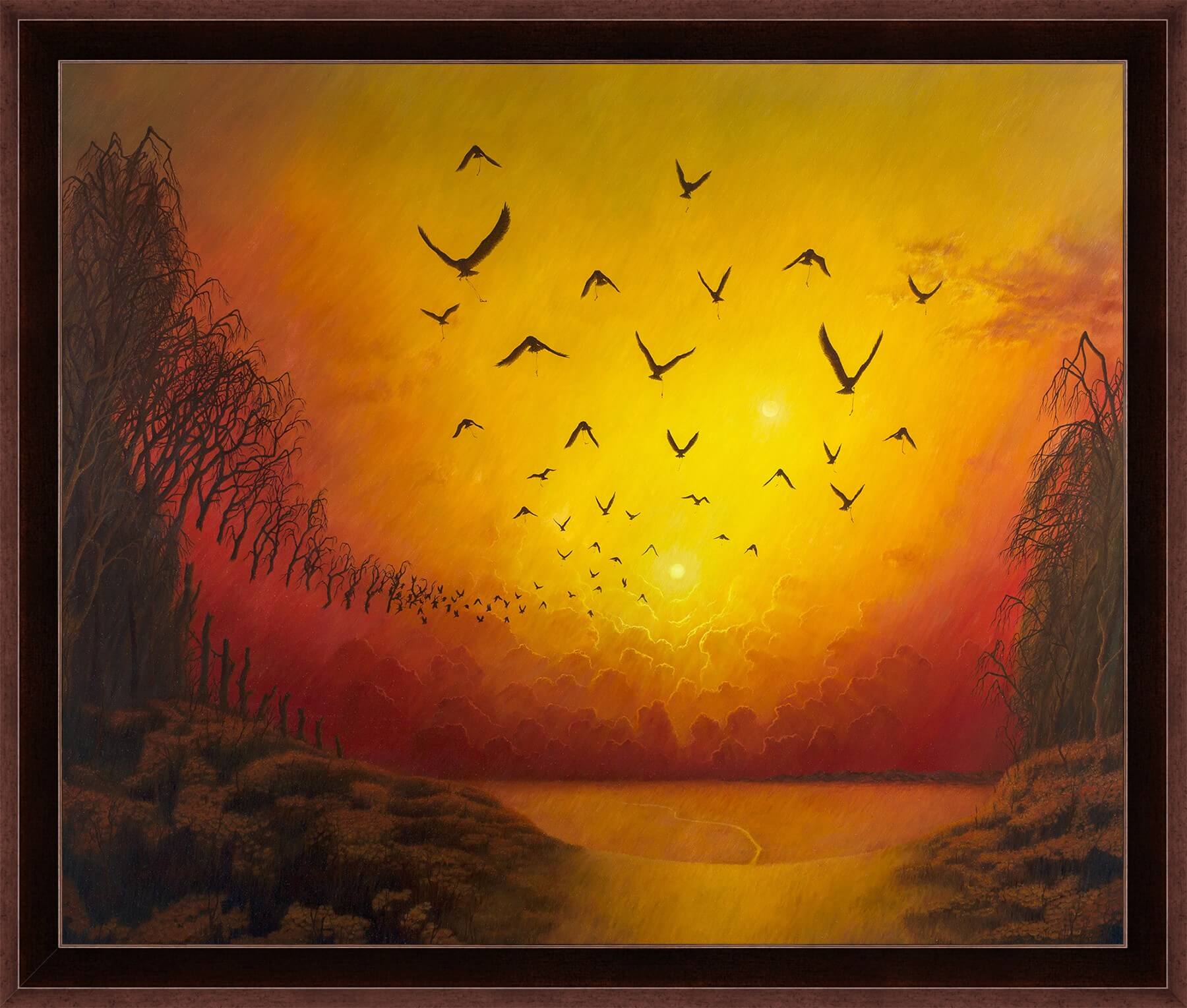
2018r, 393⁄8 x 471⁄4 in, oil on the aluminium 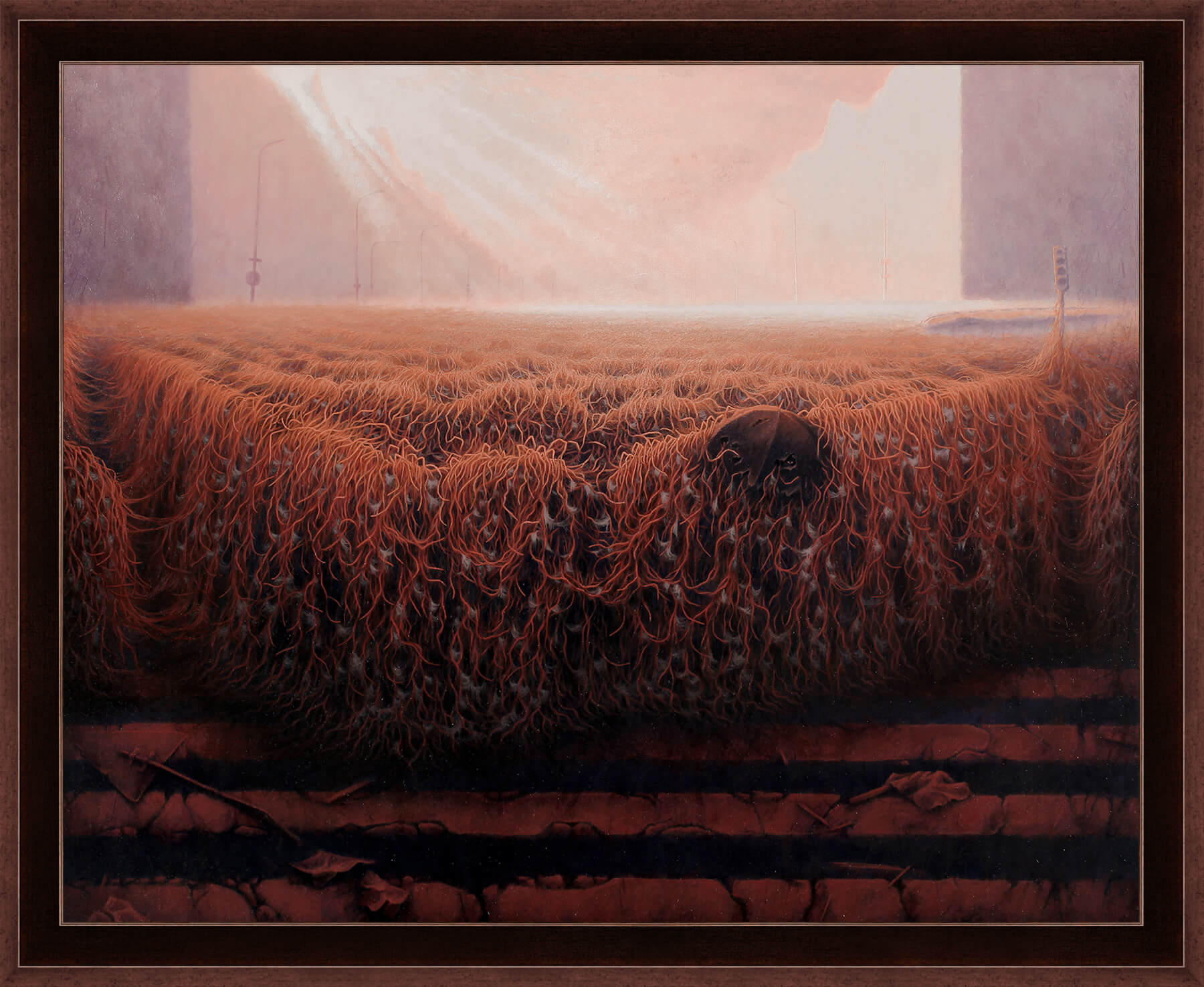
2020r, 311⁄2 x 393⁄8 in, oil on the aluminium
TEXT CONCERNING THE PAINTING OF A CITY WITH A BURNING FOURPED
The picture showing an empty city with a burning quadruped walking was created a bit faster than the previous ones. This resulted from the search for new solutions to operate with the oil technique, specifically a different method of applying paint and using a different type of brushes, previously widely omitted. As the effect was even promising, I decided to explore new possibilities and see what will come of it in the next works. I am not titling pictures on purpose. Painting of this type, i.e. mostly visionary, where the finished work more or less resembles what you have “seen” – in my opinion – it does not need titles, or even contradicts them. This is due to the structure of the picture. Just as dreams are not foreshadowed by large, gliding titles and we do not wake up when the curtain with the words “The End falls”, and the artistic vision cannot be given a title. something completely different than the beginning would suggest. This is a coincidence, which in my case is a very important creative factor. Hence my opinion is that in most cases the title is an attribute of a different type of painting and can easily be omitted. viewers. When experiencing a vision, you need to be sensitive and do not blur this gently obscuring the awareness of the film with sudden concentration of attention, because then it is easy to “turn off the channel”, which I could most easily compare to the situation of taking someone out of the thoughtful state. After a while, however, you do have some practice and control over the process. How does it look like? Contrary to appearances, this is not a complicated process and everyone, but absolutely everyone, can imagine it – literally. Well, if we think about any thing, it usually appears before our eyes in all its glory, detail, almost with photographic accuracy. It’s like putting a photo with high transparency on the eye lens, through which we see reality. Everyone has it and this is what it looks like. The process is interesting because it is usually not a problem to imagine, for example, a horse’s silhouette, which will be appropriate, in proportions and with perfect lighting. The problem arises when it is necessary to recreate the image in the form of artistic techniques. Of course, the example above is one of the many ways in which a concept for a future image is born. Returning to the topic: At one point, while sketching a completely different idea, I saw a view of the city from a certain height with a slowly walking, burning pet. A second later I had it roughly sketched. After some time, I started working on a pencil sketch on the support. Earlier, however, I considered which staff would be the most advantageous: vertical or horizontal? The level seemed more natural due to the greater sense of scale due to the width, but I had the impression that vertically the image would be stronger to perceive and the depth more distinct. Another thing was the composition: how to place the buildings? How to create an urban layout that would reflect the layout, but also not fall into perspective? “Streets” should be done diagonally or straight? Another very important issue is choosing the right lighting. On this point, I had several versions in my head fighting for priority. It may be hard to believe, but in my case it is this stage of work that I consider the hardest and probably the most important. Often these are many hours of reflection, calculation and a series of analyzed sketches. Finally, the outline of the city appeared on the vertical base, in which the most visible street ran straight, and the city itself was situated on two hills, where the first collapsed, giving the possibility of showing further plans, and the second disappeared somewhere deep in the thickening air. I put the lighting slightly on the left side, so that the shadows were filling the square on the left side and the shadows crossed the line of the “street” so that it did not seem too intrusive. I also wanted the rays of light to contrast the objects on the right. From the bottom, I wanted to get the effect of gravity, so that the whole thing shoots strongly from the bottom up. I chose the color at the end and referred to one dream I had a few years ago, where the stage was illuminated with a narcotic blue-greenish light. In the end, the color and the whole work “set” by itself, although in this case the general compositional assumption remained unchanged. In the course of work, a form of “buildings” appeared, which were originally supposed to be tied with some huge, scaled wire resembling more sheaves of hay that fly out of the combine during harvest, but the stains painted at the beginning “suggested” that the “buildings” should bear traces of strong, open damage. To make it look like “buildings” at all, I created old type radio and television antennas. Why such? I have a certain fondness for my childhood and I draw from this period details that I did not distort in this case. While painting, I found that the damage is so sufficient that no windows need to be added. It was supposed to be as dead as possible. I would also like to emphasize the deadness with a withered “tree” in the middle of the square on the left. The first brush strokes of the quadruped figure raised the question: what to choose? Horse or dog? I decided that I would not be particularly concerned with defining the species, but nevertheless it probably looks more like a dog, which perhaps fits more with the whole picture than the kind of “nobility” of a horse that this animal has in our culture. I was also wondering whether to paint the “young” walking beside the howling. Since the “old” was on fire and was supposed to burn from above, it was known that he would die, then adding “young” would theoretically emphasize his loneliness and imminent death, but it was not finally known, so I stayed with the “old” and his certain death. On the other hand, I didn’t want to escalate the drama unnecessarily. The end of a lonely animal’s life seemed enough to me. The rest “painted itself”. So it spontaneously turned out that the animal was going into darkness, as if without much (or maybe quite the opposite!) Awareness that it was burning. At one point, I felt strongly to “close” the image from above. Clouds from a certain height arranged them in this and not another way, and I left them in this form without thinking too much, although I am not sure of their form so far while writing this text. At the very end I added a few street lamps, but I didn’t want to “enliven” the whole thing too much with such details. I found them redundant. They answer the question: “Why does the picture represent what it shows?” – in short, this and the others are a reflection of myself. The city, breathless, perhaps without time, without desires, is a dead place, but it is also a city without the burden of everyday struggle for survival, without problems, without fear for something, for someone, for yourself. Such a place corresponds to a conscious resignation from everything in exchange for the total and eternally certain peace of some undefined, full of aesthetic sensations of a metaphysical existence.
